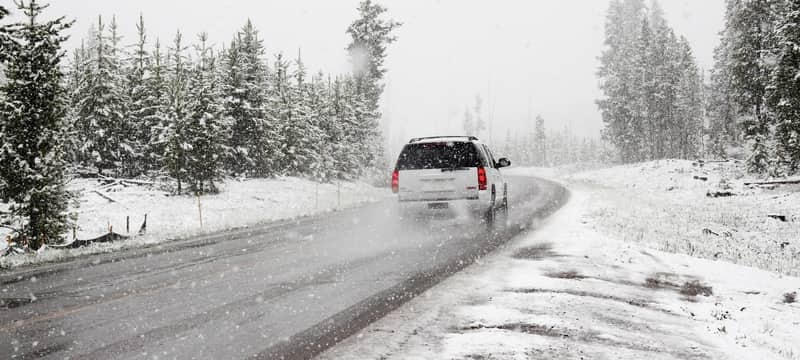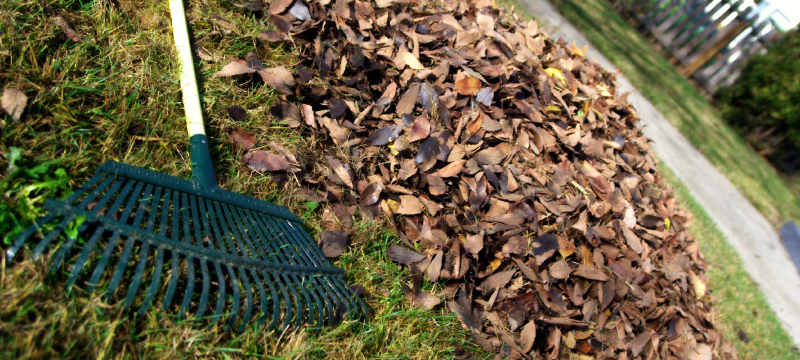Winter is a tough time of year, especially in the snowy, cold north. As leaves begin to fall and ice creeps back to our windshields in the mornings, take some time to prepare yourself for the chilly months ahead and plan on winter safety.
1. Take It Slow
Whether you’re walking or driving, there’s no need to rush when it’s slippery out. Take your time and pay attention to each step. Watch where you place each footfall, and feel for ice as you go. Wherever you’re going, you’ll take much longer if you fall and hurt yourself or if you get in an accident. Even if your truck is heavy and has all-wheel drive, you can still lose traction and spin out in the blink of an eye.
2. Wear Good Boots
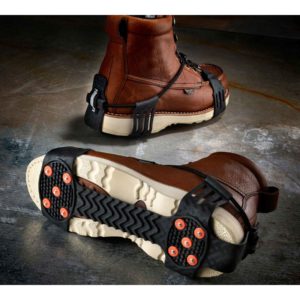 Get a solid pair of winter boots with plenty of traction. Smooth-soled shoes provide no extra traction on ice. A pair of soft-soled boots or shoes grip much better and will help you keep your feet planted underneath you. If you absolutely must wear smooth-bottom shoes, attach some removable ice spikes to get as much grip as possible.
Get a solid pair of winter boots with plenty of traction. Smooth-soled shoes provide no extra traction on ice. A pair of soft-soled boots or shoes grip much better and will help you keep your feet planted underneath you. If you absolutely must wear smooth-bottom shoes, attach some removable ice spikes to get as much grip as possible.
If you will be standing on concrete or metal for long periods of time, your feet might get pretty numb. If your warm socks aren’t cutting it this winter, you can also opt for foot warmers, or even battery-powered heated insoles to keep the feeling in your toes. Don’t let Old Man Winter get the best of you.
3. Keep An Emergency Kit In Your Car
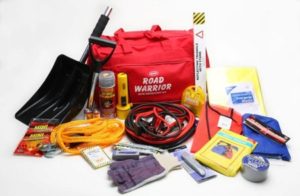
On slippery winter roads, you never know when you might spin out and land in a ditch. A good emergency kit is crucial for cold-weather driving in the north. At the very least you should have a blanket, water, emergency radio, flashlight, nonperishable snacks, and a first aid kit. Other winter car necessities include spare socks or gloves, a small shovel, a brush to clean windows, phone charger, and jumper cables. Keep all your emergency gear inside the main cabin of your car where you can reach it without having to go outside. Also, keep your gas tank full and get a new battery if you need one. No one likes jumping a car in -20 temperatures.
4. Have A First Aid Kit And Know How To Use It
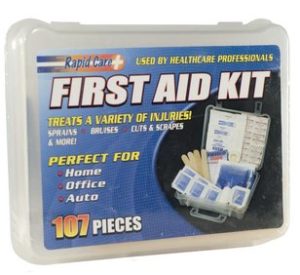 As snow falls and roads become slippery, falls and accidents are much more likely to happen. Always carry a first aid kit in your car along with your emergency kit, in case you or a passenger gets hurt. Whether it’s from slipping on a slick sidewalk or a minor fender bender, getting hurt should always be taken seriously. According to the Red Cross, your kit should contain any important medications you might need, as well as any crucial phone numbers. Be sure to check your kit on a regular basis and ensure that nothing has expired. Replace any contents that are past their “use by” date and keep it well stocked so you don’t run out of something when you need it.
As snow falls and roads become slippery, falls and accidents are much more likely to happen. Always carry a first aid kit in your car along with your emergency kit, in case you or a passenger gets hurt. Whether it’s from slipping on a slick sidewalk or a minor fender bender, getting hurt should always be taken seriously. According to the Red Cross, your kit should contain any important medications you might need, as well as any crucial phone numbers. Be sure to check your kit on a regular basis and ensure that nothing has expired. Replace any contents that are past their “use by” date and keep it well stocked so you don’t run out of something when you need it.
First aid kits are available in a wide variety of sizes and prices, from small to large variations. There are also kits made specifically for car use, so be sure to get the best kit for your needs.
5. Warm Up Before Shoveling
Fresh snow is pretty, but it also gets in the way. Shoveling is a chore with which us northerners are all too familiar, but it’s actually much more dangerous than many realize. Large volumes of snow get heavy really fast, and all that strain takes a toll on your body lifting and tossing it for a few hours. Strenuous activity in the cold air also requires much more exertion than in warm air and takes a larger toll on your body. Start slow and never lift more than you’re comfortable with.
6. Walk Like A Penguin
 Think like your favorite Antarctic bird and you’ll have a much better time this winter. Center your weight over your feet and take short, careful steps. Focus on each foot placement, and don’t let your legs spread out too much. Stepping too far in front of you will cause that foot to slide out from under you, and you’ll be on the ground before you know it.
Think like your favorite Antarctic bird and you’ll have a much better time this winter. Center your weight over your feet and take short, careful steps. Focus on each foot placement, and don’t let your legs spread out too much. Stepping too far in front of you will cause that foot to slide out from under you, and you’ll be on the ground before you know it.
Yes, you will look silly waddling around, but at least you won’t end up on your tush.
7. Tell People Where You’re Going
Whenever you’re going anywhere in the winter, tell someone your plan and when you plan to be back. Especially if you’re driving somewhere more remote, like through the country, where there might not be someone around to find you if you need help. Even if you’re just walking somewhere too, be sure that at least someone knows your destination. If they hear that you didn’t make it when you thought you would, they can reach out to you and offer help or send someone else who can assist.
8. Get Rid Of The Snow And Ice
 Use plenty of salt and sand to get as much traction as possible. Shovel and scrape as much snow and ice off the ground as possible to maximize contact with the pavement as you walk. Be extra thorough while cleaning steps or inclines, or any other place where a fall is riskier. Spreading sand can be another useful way to gain some extra traction underfoot. If ice is really stuck to the ground, use a dedicated ice scraping tool to break it apart and clean right down to the pavement.
Use plenty of salt and sand to get as much traction as possible. Shovel and scrape as much snow and ice off the ground as possible to maximize contact with the pavement as you walk. Be extra thorough while cleaning steps or inclines, or any other place where a fall is riskier. Spreading sand can be another useful way to gain some extra traction underfoot. If ice is really stuck to the ground, use a dedicated ice scraping tool to break it apart and clean right down to the pavement.
9. Always Wear Proper Clothes
Even if you’re driving somewhere nearby, always wear warm clothes. Extremities get cold faster than your core, so wear warm socks, preferably wool, as well as gloves or mittens, and a hat. Dressing in layers is the best way to prepare yourself for cold conditions too, and you can always shed a layer or two if you get too warm. If you’re still afraid of catching shivers, try using a heated hoodie or jacket to ward off any unwanted teeth chattering.
Brightly-colored clothing can also be useful during the long nights. Bright and reflective clothes make you easier to see for drivers after dark, increasing your overall safety. Never wear dark clothes when walking at night; the more obnoxious you look, the easier it is for drivers to see and avoid you.
10. Check Road Conditions Before Driving
Severe weather alert systems are in place to ensure that drivers know what the roads are like before heading out. If the roads look dicey, stay inside and save yourself the trouble. Check with your local Department of Transportation, pay attention to weather forecasts, and listen to emergency weather radios if you suspect that driving might not be safe. Ending up in a ditch or a collision center isn’t worth your time when Jack Frost is having a tantrum.
11. Keep A Shovel And Brush In Your Car
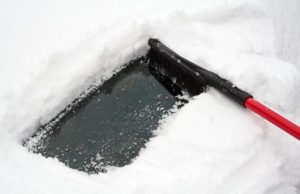 Keep the right tools in your car for winter. Always brush and scrape snow off the windshield and ice from the windows. With already-hazardous conditions, the last thing you need is reduced visibility.
Keep the right tools in your car for winter. Always brush and scrape snow off the windshield and ice from the windows. With already-hazardous conditions, the last thing you need is reduced visibility.
Shovels are useful for removing snow, but sometimes you actually need to put snow back on a walkway. Sprinkling a little bit of powder on an icy surface can help give you a little bit of extra traction, and every little bit helps. Some small shovels collapse down small enough to fit easily in the trunk of your car, so you can always have one around. Plus, if your parked car gets plowed in, you will be ready to break through the snow pile and get back on the road.
We hope you stay safe this winter. Need more resources? Check out acmetools.com for more winter gear and our blog for more ideas. Be sure to read about heated jackets or the new Milwaukee Tools Heated Gear for this year.
Sources:
https://www.cdc.gov/disasters/winter/duringstorm/outdoorsafety.html
https://www.redcross.org/get-help/how-to-prepare-for-emergencies/anatomy-of-a-first-aid-kit.html

